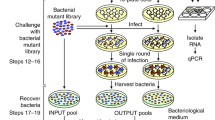Abstract
Functional identification of genes is an efficient way to study many biological processes in lower eukaryotes. However, an effective approach in mammalian cells is still under development. We designed a functional gene identification procedure and applied it in a study of tumor necrosis factor (TNF)-induced cell killing. This procedure employed a specially designed retroviral vector that allows random truncation of genes, efficiently selecting clones in which a gene was disrupted and quickly identifying disrupted genes. We have identified several novel genes by a preliminary test of this approach and confirmed by reconttitution that the genes we identified are required for TNF cytotoxicity in L929 cells. Because of the efficient identification of these components in TNF-induced cell killing, we have already been able to outline the killing pathway of TNF in L929 cells. Application of this method could be widespread because it can be used in studying any cellular responses if a specific selection assay can be set up.
Similar content being viewed by others
References
Oliver SG: From DNA sequence to biological function. Nature 1996;379:597–600.
Nohturfft A, et al.: Recurrent G-to-A substitution in a single codon of SREBP cleavage-activating protein causes sterol resistance in three mutant Chinese hamster ovary cell lines. Proc Natl Acad Sci USA 1996;93:13,709–13,714.
Habets GGM, et al.: Identification of an invasion-inducing gene-Tiam-1, that encodes a protein with homology to GDP-GTP exchangers for Rho-like proteins. Cell 1994; 77:537–549.
Hicks GG, et al.: Functional genomics in mice by tagged sequence mutagenesis. Nat Genetics 1997;16:338–344.
Andreu T, et al.: Gene trapping identifies inhibitors of oncogenic transformation. J Biol Chem 1998;273:13,848–13,854.
Agthoven TV: Identification of BCAR3 by a random search for genes involved in antiestrogen resistance of human breast cancer cells. EMBO J 1998;17:2799–2808.
Russ AP, et al.: Identification of genes induced by factor deprivation in hematopoietic cells under-going apoptosis using gene-trap mutagenesis and site-specific recombination. Proc Natl Acad Sci USA 1996;93:15,279–15,284.
Friedrich G, Soriano P: Promoter traps in embryonic stem cells: a genetic secreen to identify and mutate developmental genes in mice. Genes Dev 1991;5: 1513–1523.
Sharnes WC, Auerbach BA, Joyner AL: A gene trapapproach in mouse embryonic stem cells: the lac Z reporter is activated by splicing, reflects endogenous gene expression, and is mutagenic in mice. Genes Dev 1992;6:903–918.
Evans MJ, Carlton MBL, Russ AP: Gene trapping and functional genomics. TIG 1997;13: 370–374.
Borstein P, et al.: Metaxin, a gene contiguous to both throm bospondin 3 and glucocerebrosidase, is required for embryonic development in the mouse: implications for Gaucher disease. Proc Natl Acad Sci USA 1995;92:4547–4551.
Deiss LP, Kimchi A: A genetic tool used to identify thioredoxin as a mediator of a growth inhibitory signal. Science 1991;235:117–120.
Vito P, Lacana E, D'Adamino L: Interfering with apoptosis: Ca2+-binding protein ALG-2 and Alzheimer's disease gene ALG-3. Science 1996;271:521–525.
Hannon GJ, et al.: MaRX: an approach to genetics in mammalian cells. Science 1999; 283:1129–1130.
Krol ARVD, Mol JNM, Stuitje AR: Modulation of eukaryotic gene expression by complementary RNA or DNA sequences. BioTechniques 1988;6:958–976.
Wilthers-Ward ES, et al.: Distribution
Author information
Authors and Affiliations
Rights and permissions
About this article
Cite this article
Wang, X., Han, J. Elucidating tumor necrosis factor signaling pathway using a functional gene ddentification approach. Immunol Res 21, 55–61 (2000). https://doi.org/10.1385/IR:21:2-3:55
Issue Date:
DOI: https://doi.org/10.1385/IR:21:2-3:55




